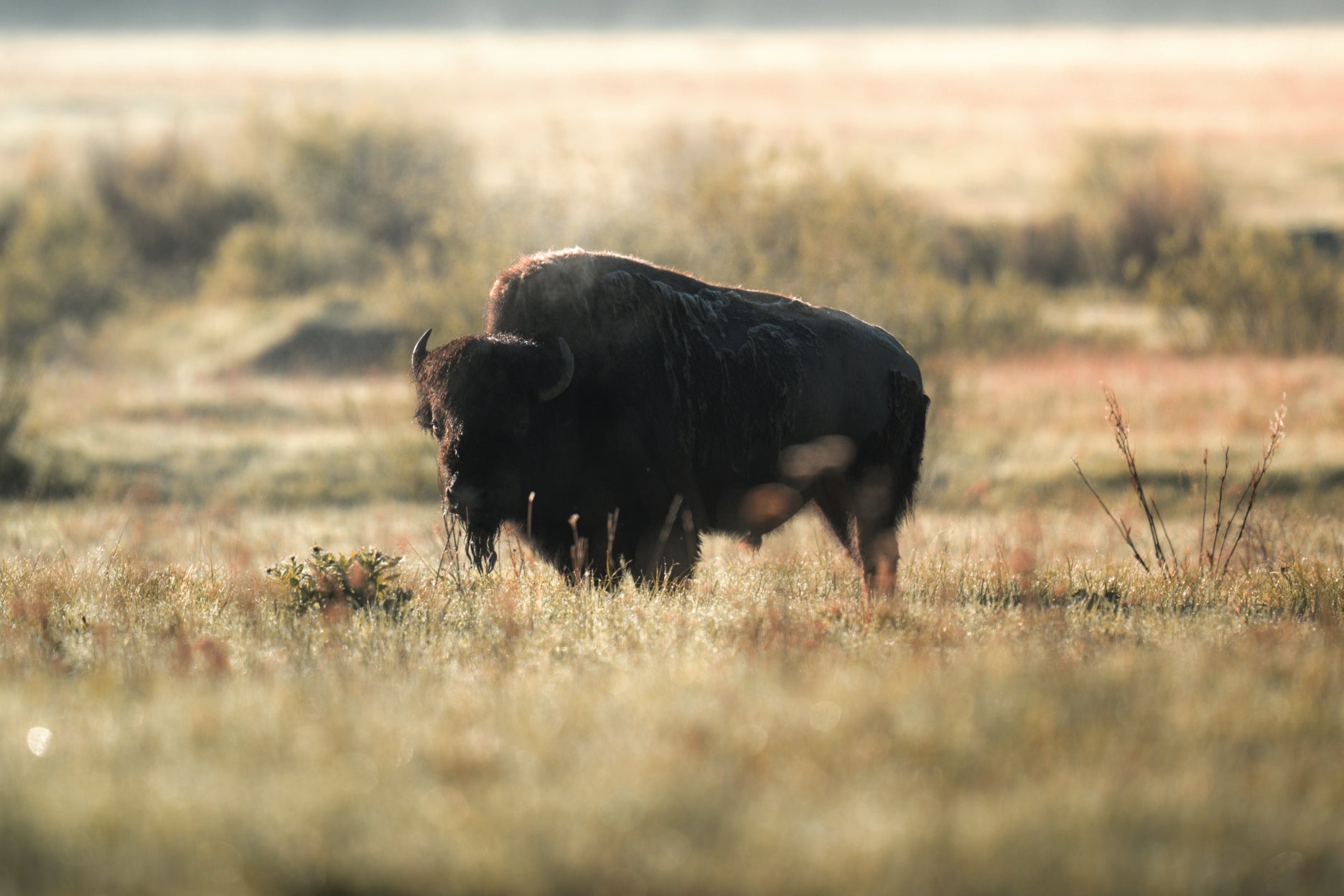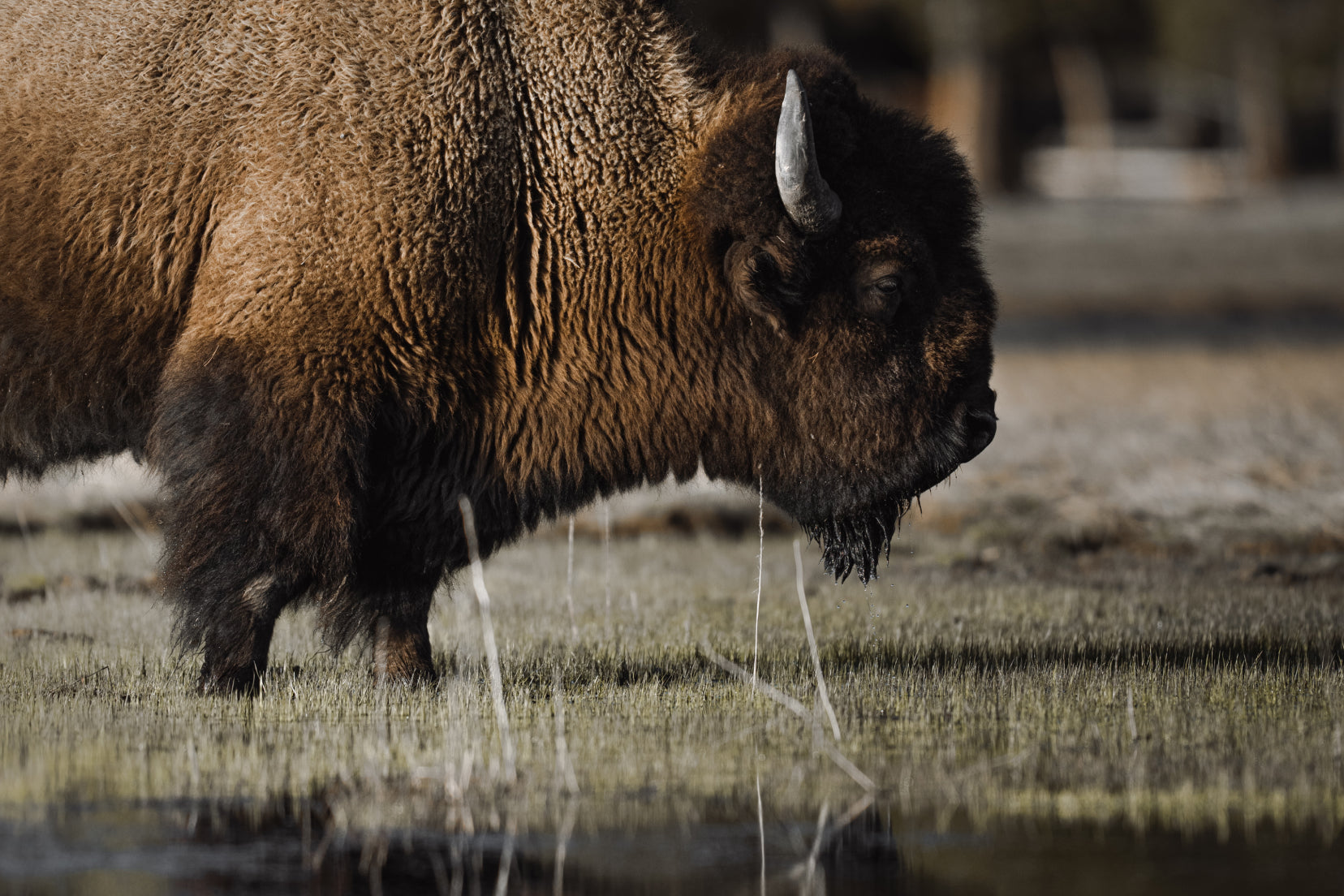
July marks National Bison Month, a time to honor the enduring spirit of an animal once nearly erased from the North American landscape. But this year, the celebration carries extraordinary resonance: for the first time in modern history, genetically pure Yellowstone bison have been transferred across the U.S.-Canada border to the Mosquito, Grizzly Bear’s Head, Lean Man First Nations in Saskatchewan. This historic gift—11 bison, including three bulls, seven cows, and one calf—was made possible through the collaborative work of the Fort Peck Assiniboine and Sioux Tribes, Indigenous partners, and a network of conservationists and nonprofit organizations, including the Bison Conservation and Transfer Program supported by Yellowstone Forever. But more than a logistical achievement, the transfer is a deeply symbolic act of reconciliation, renewal, and return.
“This beautiful gift is deeply meaningful as we collectively rebuild our relationship to them as they teach us perseverance, strength, and determination,” said Chief Tanya Stone of Mosquito, Grizzly Bear’s Head, Lean Man First Nations. Her words reflect the sacred and spiritual ties between Indigenous peoples and buffalo, relationships that were severed through colonial violence and environmental destruction, but are now being mended through intertribal solidarity and ceremony.
The transfer is part of a Buffalo Treaty between tribal nations in the U.S. and Canada, a cross-border agreement first signed in 2014 committed to the restoration of buffalo across their ancestral lands. Fort Peck, a founding signatory, has emerged as a central hub in this effort—both spiritually and logistically—through its participation in the Yellowstone Bison Conservation and Transfer Program (BCTP). Launched in 2019, the BCTP is a partnership among the National Park Service, USDA, Tribal Nations, and conservation organizations that seeks to preserve Yellowstone bison genetics, reduce the need for culling, and rehome healthy bison to Indigenous communities across the continent.
The family group transferred this summer underwent rigorous testing for brucellosis—a disease of concern for domestic livestock industries in both the U.S. and Canada. Once cleared, the bison traveled over 700 miles from Montana to Saskatchewan, accompanied by members of the Fort Peck Pte’ Group and other Indigenous leaders, who traveled not just with the animals, but with stories, songs, and prayers across the border.
“It’s an exciting time, returning our genetically pure relatives from Yellowstone across our invisible boundary that they once roamed freely,” said Lewis Matthews, Chief of Police at Fort Peck. “Those days of free roaming have been long gone, but the American bison is continuing to be placed back in their native lands. These bison will provide traditional reconnection as they did in the past.”
This transfer marks not only the first time Yellowstone bison have returned to Canada in modern memory, but also a tangible embodiment of the Interagency Bison Management Plan (IBMP)—an agreement forged in 2000 among federal agencies, Montana state officials, and Tribal Nations to balance the complex, often contentious management of Yellowstone’s iconic herd. Unlike other wildlife, bison migration from the park is restricted by jurisdictional boundaries and land-use conflicts, particularly due to concerns from ranchers about disease transmission. The BCTP and IBMP together provide a framework for overcoming these hurdles, working to replace slaughter with sanctuary, and conflict with cooperation wherever possible.
To date, more than 400 Yellowstone-origin bison have been transferred to 30 tribes in 13 U.S. states and Canada through this growing network. This year’s delivery to First Nations peoples is both a continuation and a beginning, a gesture that rekindles and reflects a deeper vision of interdependence.
“A traditional gifting economy was once practiced by the First Nations living on the Great Plains of North America,” said Dr. Leroy Little Bear, speaking on behalf of the Buffalo Treaty. “This present-day gifting of Yellowstone buffalo by Fort Peck… shows that both nations are implementing the intent of the Buffalo Treaty: which is cooperation, renewal, and restoration of the Buffalo.”
As buffalo hoofbeats return to the prairies of Saskatchewan, they bring with them more than ecological restoration. In a world fractured by borders and bureaucracy, they carry the weight of kinship, sovereignty, and the living pulse of intergenerational healing.
July marks National Bison Month, a time to honor the enduring spirit of an animal once nearly erased from the North American landscape. But this year, the celebration carries extraordinary resonance: for the first time in modern history, genetically pure Yellowstone bison have been transferred across the U.S.-Canada border to the Mosquito, Grizzly Bear’s Head, Lean Man First Nations in Saskatchewan. This historic gift—11 bison, including three bulls, seven cows, and one calf—was made possible through the collaborative work of the Fort Peck Assiniboine and Sioux Tribes, Indigenous partners, and a network of conservationists and nonprofit organizations, including the Bison Conservation and Transfer Program supported by Yellowstone Forever. But more than a logistical achievement, the transfer is a deeply symbolic act of reconciliation, renewal, and return.
“This beautiful gift is deeply meaningful as we collectively rebuild our relationship to them as they teach us perseverance, strength, and determination,” said Chief Tanya Stone of Mosquito, Grizzly Bear’s Head, Lean Man First Nations. Her words reflect the sacred and spiritual ties between Indigenous peoples and buffalo, relationships that were severed through colonial violence and environmental destruction, but are now being mended through intertribal solidarity and ceremony.
The transfer is part of a Buffalo Treaty between tribal nations in the U.S. and Canada, a cross-border agreement first signed in 2014 committed to the restoration of buffalo across their ancestral lands. Fort Peck, a founding signatory, has emerged as a central hub in this effort—both spiritually and logistically—through its participation in the Yellowstone Bison Conservation and Transfer Program (BCTP). Launched in 2019, the BCTP is a partnership among the National Park Service, USDA, Tribal Nations, and conservation organizations that seeks to preserve Yellowstone bison genetics, reduce the need for culling, and rehome healthy bison to Indigenous communities across the continent.
The family group transferred this summer underwent rigorous testing for brucellosis—a disease of concern for domestic livestock industries in both the U.S. and Canada. Once cleared, the bison traveled over 700 miles from Montana to Saskatchewan, accompanied by members of the Fort Peck Pte’ Group and other Indigenous leaders, who traveled not just with the animals, but with stories, songs, and prayers across the border.
“It’s an exciting time, returning our genetically pure relatives from Yellowstone across our invisible boundary that they once roamed freely,” said Lewis Matthews, Chief of Police at Fort Peck. “Those days of free roaming have been long gone, but the American bison is continuing to be placed back in their native lands. These bison will provide traditional reconnection as they did in the past.”
This transfer marks not only the first time Yellowstone bison have returned to Canada in modern memory, but also a tangible embodiment of the Interagency Bison Management Plan (IBMP)—an agreement forged in 2000 among federal agencies, Montana state officials, and Tribal Nations to balance the complex, often contentious management of Yellowstone’s iconic herd. Unlike other wildlife, bison migration from the park is restricted by jurisdictional boundaries and land-use conflicts, particularly due to concerns from ranchers about disease transmission. The BCTP and IBMP together provide a framework for overcoming these hurdles, working to replace slaughter with sanctuary, and conflict with cooperation wherever possible.
To date, more than 400 Yellowstone-origin bison have been transferred to 30 tribes in 13 U.S. states and Canada through this growing network. This year’s delivery to First Nations peoples is both a continuation and a beginning, a gesture that rekindles and reflects a deeper vision of interdependence.
“A traditional gifting economy was once practiced by the First Nations living on the Great Plains of North America,” said Dr. Leroy Little Bear, speaking on behalf of the Buffalo Treaty. “This present-day gifting of Yellowstone buffalo by Fort Peck… shows that both nations are implementing the intent of the Buffalo Treaty: which is cooperation, renewal, and restoration of the Buffalo.”
As buffalo hoofbeats return to the prairies of Saskatchewan, they bring with them more than ecological restoration. In a world fractured by borders and bureaucracy, they carry the weight of kinship, sovereignty, and the living pulse of intergenerational healing.
“This beautiful gift is deeply meaningful as we collectively rebuild our relationship to them as they teach us perseverance, strength, and determination,” said Chief Tanya Stone of Mosquito, Grizzly Bear’s Head, Lean Man First Nations. Her words reflect the sacred and spiritual ties between Indigenous peoples and buffalo, relationships that were severed through colonial violence and environmental destruction, but are now being mended through intertribal solidarity and ceremony.
The transfer is part of a Buffalo Treaty between tribal nations in the U.S. and Canada, a cross-border agreement first signed in 2014 committed to the restoration of buffalo across their ancestral lands. Fort Peck, a founding signatory, has emerged as a central hub in this effort—both spiritually and logistically—through its participation in the Yellowstone Bison Conservation and Transfer Program (BCTP). Launched in 2019, the BCTP is a partnership among the National Park Service, USDA, Tribal Nations, and conservation organizations that seeks to preserve Yellowstone bison genetics, reduce the need for culling, and rehome healthy bison to Indigenous communities across the continent.
The family group transferred this summer underwent rigorous testing for brucellosis—a disease of concern for domestic livestock industries in both the U.S. and Canada. Once cleared, the bison traveled over 700 miles from Montana to Saskatchewan, accompanied by members of the Fort Peck Pte’ Group and other Indigenous leaders, who traveled not just with the animals, but with stories, songs, and prayers across the border.
“It’s an exciting time, returning our genetically pure relatives from Yellowstone across our invisible boundary that they once roamed freely,” said Lewis Matthews, Chief of Police at Fort Peck. “Those days of free roaming have been long gone, but the American bison is continuing to be placed back in their native lands. These bison will provide traditional reconnection as they did in the past.”
This transfer marks not only the first time Yellowstone bison have returned to Canada in modern memory, but also a tangible embodiment of the Interagency Bison Management Plan (IBMP)—an agreement forged in 2000 among federal agencies, Montana state officials, and Tribal Nations to balance the complex, often contentious management of Yellowstone’s iconic herd. Unlike other wildlife, bison migration from the park is restricted by jurisdictional boundaries and land-use conflicts, particularly due to concerns from ranchers about disease transmission. The BCTP and IBMP together provide a framework for overcoming these hurdles, working to replace slaughter with sanctuary, and conflict with cooperation wherever possible.
To date, more than 400 Yellowstone-origin bison have been transferred to 30 tribes in 13 U.S. states and Canada through this growing network. This year’s delivery to First Nations peoples is both a continuation and a beginning, a gesture that rekindles and reflects a deeper vision of interdependence.
“A traditional gifting economy was once practiced by the First Nations living on the Great Plains of North America,” said Dr. Leroy Little Bear, speaking on behalf of the Buffalo Treaty. “This present-day gifting of Yellowstone buffalo by Fort Peck… shows that both nations are implementing the intent of the Buffalo Treaty: which is cooperation, renewal, and restoration of the Buffalo.”
As buffalo hoofbeats return to the prairies of Saskatchewan, they bring with them more than ecological restoration. In a world fractured by borders and bureaucracy, they carry the weight of kinship, sovereignty, and the living pulse of intergenerational healing.

WRITTEN BY JMM
#Stewardship